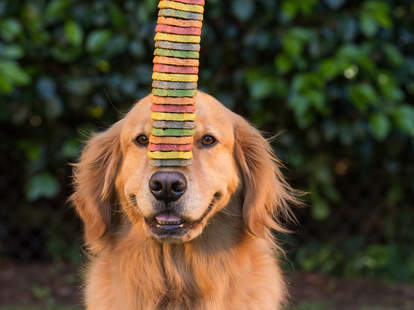
Shutterstock
While training pets can be challenging, a pocket full of treats will go a long way in your adventure together. But if you aren’t careful, treat training can lose its meaning, making it tougher to learn in the long run. We spoke to animal behaviorist Kelly Ballantyne about the best ways to motivate your pet with treats — plus some of her tricks of the trade.
While positive reinforcement with treats is Ballantyne’s go-to training tool, it comes with pitfalls. “It’s important that you use treats strategically to reward desirable behaviors,” Ballantyne told The Dodo. “If you’re randomly feeding your pet treats, it becomes less clear.” If you’re training in a low-distraction setting, like your living room, you should be fine using your pet’s normal dog food as reinforcement. Just make it clear to them what you want by feeding them the food immediately after they do the behavior you’re looking for!
While normal pet food will be fine in that low-distraction environment, training outside, where you’re competing with squirrels, other dogs passing by and the full spectrum of outdoor smells, calls for the pulling out the heavy hitters, like fresh or freeze-dried treats. “Dry biscuit treats don’t seem high-value enough if it’s a distracting environment,” Ballantyne said.
If you’re bringing the good stuff to the park, you don’t need a big treat to do the job. “Most commercial treats are bigger than they need to be,” Ballanytne said. “I’ll break a training treat into thirds or quarters. You get more opportunities to reward with smaller treats.” Plus, smaller treats mean moving onto the next part of training faster instead of waiting for your pet to work through a full Milk-Bone.

Sure, all treat training comes down to a behavior-reward relationship, but there’s still a right way to do it. “You don’t want to wave the treat in front of the dog or cat’s face to induce the behavior,” Ballantyne said. “If you always do that, the food becomes part of the cue — so if you don’t have the treat, it could be confusing.” Your goal should be to get your pet to respond to hand signals, not treats, as soon as they’re able. But if your pet is struggling to pick up hand signals, it doesn’t hurt to have treats stashed around the house to quickly add some motivation wherever you are.
Speaking of stashes, keep a few different kinds of treats on hand so you can keep it exciting for your pet. “Say you’re always using cheese on a walk [as motivation],” Ballantyne said. “Eventually, because it’s routine, it loses value. But if you switch, it’ll keep some variety and novelty.” Balantyne likes to switch between freeze-dried treats, peanut-butter-flavored treats and some one-offs to keep things interesting. Either way, give them a test run before you buy them in bulk. “Some of the richer treats might cause them an upset stomach,” Ballantyne said.

Keep in mind that, while training time might be a specific moment of the day for you, it’s a 24/7 deal for your pet. If they randomly do something you like during the day, make sure you’re equipped with treats to encourage them, Ballantyne said. If you don’t react to, say, a dog that waits patiently to cross the street on a leash, they won’t think it’s something you want anymore. Every moment with your pet is a learning opportunity!
Written by Max Plenke. Max is an editor at The Dodo. He’s Minnesotan and loud, the irony of which he understands. He has yelled “baby pit bull outside!” to his fiancé many times.
